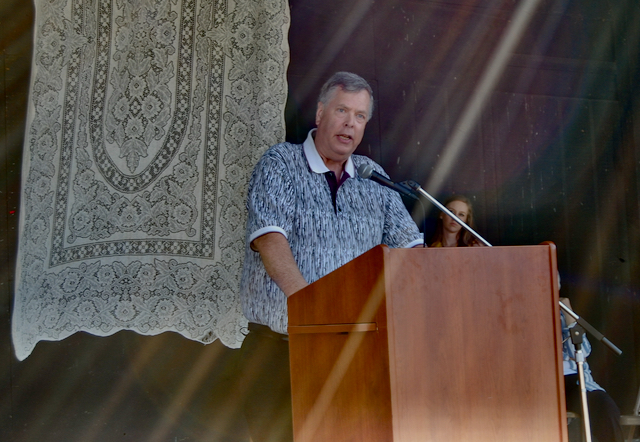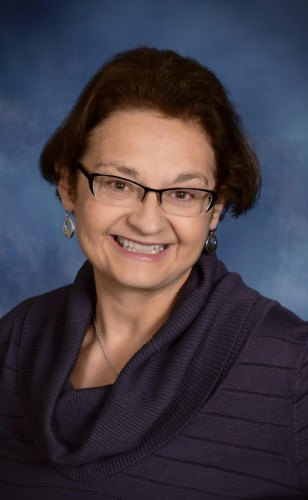By Chris Spangler
Cheryl Stedman was a strong, vibrant woman who did not let the likes of Lupus or kidney disease stop her from living life to the fullest. But sadly, she met her match in COVID-19.
David Stedman of Fort Atkinson shared his late wife’s story Friday morning as the Jefferson County Health Department hosted “Commemorating a Small Town’s Resiliency in a Pandemic” at Jefferson County Fair Park.
David’s wife of 36 years, Cheryl, was among the Jefferson County residents to have lost their lives to COVID-19. They include 113 confirmed and 21 probable deaths due to the coronavirus.
She passed away Dec. 23, 2020, at age 59.
The Stedmans met while attending the University of Wisconsin-Stevens Point and were married in 1984. Retiring in 2020 after working 31 years at Highsmith Company/Demco, Cheryl was very active in her church, community theater and Lions International.
Diagnosed with Lupus in 1989, Cheryl volunteered with the National Kidney Foundation of Wisconsin and the UW Health Organ and Tissue Organization promoting kidney disease education and organ/tissue donor awareness.
She underwent a successful kidney transplant in 2016 … but lost her life just four years later to the coronavirus.
“Thanksgiving 2020 was about the same as it had been the year before,” David shared during his remarks Friday morning. “Normally, we would have gotten together with family, but due to my nephew’s farming accident at Halloween in 2019, my wife and I had been forced to spend Thanksgiving by ourselves again. Only this time, the coronavirus pandemic would be the cause, and I had no idea this would be the last holiday I would spend with my dear wife, Cheryl.”
David works in healthcare and, during the pandemic, he was being tested for COVID-19 twice a week. However, on Nov. 22, 2020, he said, he was notified that the test he took on Nov. 20 came back positive … just three days after a negative result from his previous test.
“The Jefferson County Health Department performed their contact tracings the day after Thanksgiving and asked if anyone besides myself had been showing any COVID symptoms, and I told them that Cheryl started having symptoms the day before Thanksgiving,” David recalled.
Thanksgiving Day itself was pretty much normal, he said, but the day after, the Health Department suggested that Cheryl be tested for COVID-19.
“Because of the holiday, the nearest place to get a test was the Alliant Energy Center in Madison. We drove to Madison and Cheryl received her test and had the results a day later, which came back positive.” David said.
Throughout the following weekend, Cheryl’s symptoms worsened.
“On Dec. 1st, I finally had decided that we could no longer try to treat symptoms at home, as Cheryl had become much weaker and the cough was getting worse,” he said. “So an ambulance was called and Cheryl was transported to the hospital in Fort Atkinson. She was checked over for a time, but actually was sent home, as the blood oxygen level was still in a normal range.”
He continued: “That night, Cheryl slept on our downstairs couch while I tried sleeping in the recliner. The next morning when I checked her blood oxygen level with the monitor they sent home with her, it had dropped significantly. While doing our videoconference protocol in the afternoon, it was determined that she needed to get back to the hospital for further evaluation.
“I drove her to the hospital, and little did I know that that would be the last time to see her before having to say my goodbyes to her at University Hospital in Madison just two days before Christmas.”
He noted that Cheryl having been a kidney transplant recipient made her a high-risk individual for any type of infections or viruses, and “sadly, COVID was the one mountain she couldn’t climb of all the battles she had encountered in her life … She had beaten them all before, but the pneumonia that developed in her lungs due to the coronavirus was too much for her this time.”
Not being able to be at Cheryl’s side was heartwrenching, David shared.
“Knowing a loved one is struggling with this dreaded disease when you can’t hold their hand or be with them, and all you can rely on is phone communication from the hospital while you hold a constant vigil at home, is the hardest thing I have ever had to do in my life,” he said.
David said that he was fortunate to have several support networks to help him through Cheryl’s hospitalization and death, but even despite that assistance, there are “times you feel alone, helpless, but are grateful for the people that are there to pick you back up again.
“Most of us know that there are seven stages of grief, and one finds themselves waffling through those stages and going back and forth over a wave of different emotions like a rollercoaster ride,” David said.
He expressed thanks for having been given many tools and resources to help him navigate what is a fairly recent “new normal” with which he must cope.
“There are lots of triggers that cause you to weep when you come to the realization that Cheryl isn’t here anymore to share her smile or zest for life, but then there are those moments when the memories of her help you move forward and realize that the memories are what are best to hold onto because you can’t change the past or bring her back,” David said.
He thanked WMTV/Channel 15 in Madison for doing a story on high-risk patients battling COVID 19 and its follow-up on Christmas Eve the day after she passed. He also thanked the Daily Jefferson County Union and Fort Atkinson Community Theatre for their articles dealing with her legacy of giving and her passion for the arts.
“Cheryl was always about education, and by sharing her story, it has always been my hope that in some small way, a life could be saved, or someone could be encouraged to get involved with their community and make a difference,” David said.
He also offered his thanks to the members of the Lions Clubs International family and particularly, the Jefferson Lions Club, for honoring of Cheryl’s memory in numerous tributes, including planting a tree in her memory at Crawfish River Park; Cindy Herbst, director of the Restoring Hope Transplant House in Middleton; his pastor, the Rev. Chris Buckingham-Taylor; Cheryl’s siblings; Dawn Lyons-Wood, for sponsorship of the book “Because of Organ Donation”; University Hospital staff; his First Congregational United Church of Christ family, friends and relatives for their love, support and nurturing through meals and tokens of love and caring; and to all who gave monetary contributions to the many organizations in which Cheryl was involved.
“And (thanks) to the Jefferson County Health Department, for allowing me to speak today and to share Cheryl’s COVID journey,” he said. “Pray we never have to experience another pandemic, where over 600,000 lives and counting were lost, ever again.”

David Stedman addresses a group of about 30 people attending a Jefferson County Health Department hosted program titled: “Commemorating a Small Town’s Resiliency in a Pandemic.” The event was held at the Jefferson County Fair Park Friday. Stedman, a resident of Fort Atkinson, recounted the events leading up to the loss of his wife of 36 years, Cheryl, who died last December after contracting COVID-19. She was 59. Kim McDarison photo.

Cheryl Stedman
Photo supplied.

David Stedman of Fort Atkinson recalls his wife, Cheryl’s, death from COVID-19 two days before Christmas 2020. He was among the speakers at “Commemorating a Small Town’s Resiliency in a Pandemic,” which the Jefferson County Health Department hosted Friday morning at Jefferson County Fair Park. In the foreground is a painting by Robin Chamberlain Sweeney representing abundance, hope and the future. It will hang in the Hoard Historical Museum in Fort Atkinson through July 2 and then be displayed permanently in the Health Department lobby. Kim McDarison photo.
This post has already been read 2888 times!